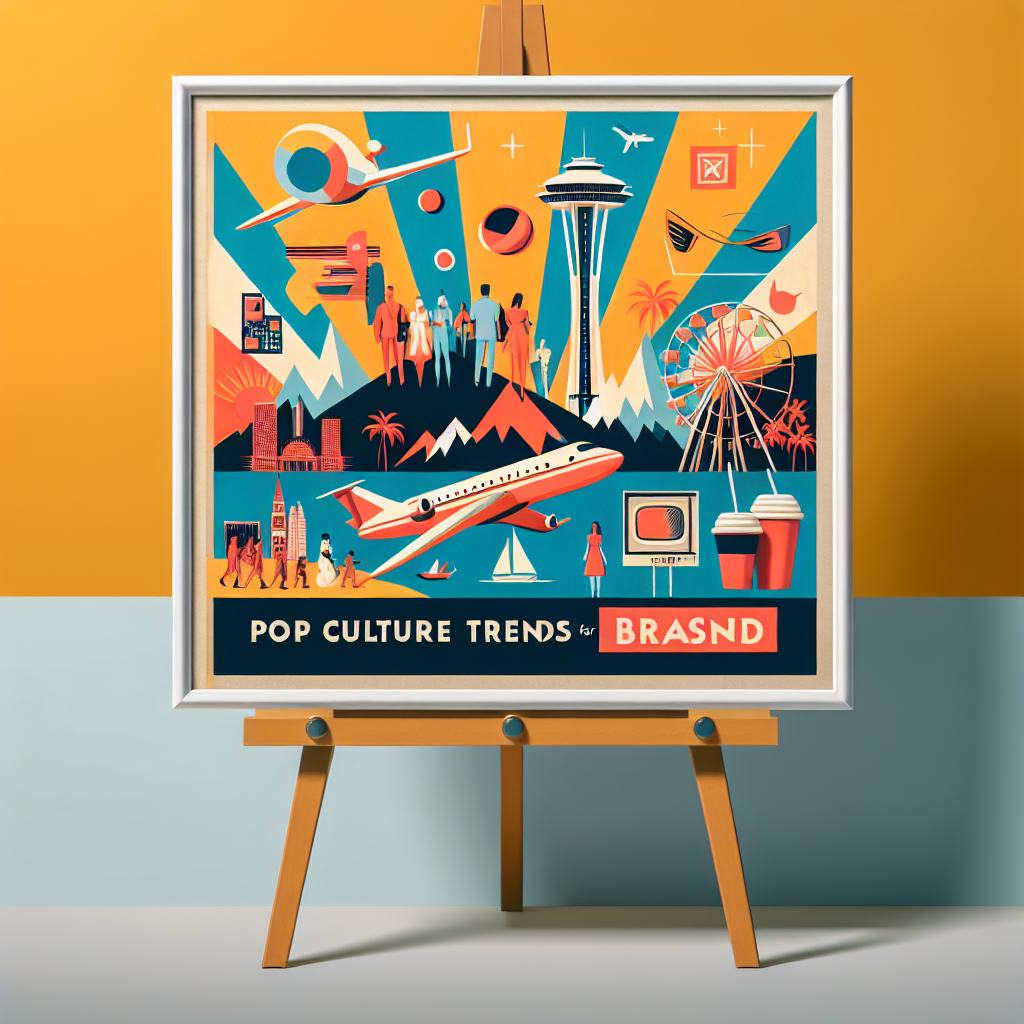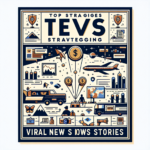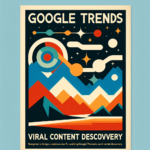Introduction: Making Your Brand Shine with Pop Culture Trends
Ever wondered how some brands manage to stay on everyone’s lips? Or how they create content that goes viral? The secret lies in leveraging pop culture trends for effective brand promotion. I’ll be breaking down the process in this blog post, with tips on how to spot relevant trends, ensuring they fit with your brand identity, creating engaging content around them, and measuring their impact on campaign success.
Did you know that, according to Nielsen, 56% of consumers are more likely to buy a product they saw endorsed by a positive online review? As such, we’ll discuss how to expand the use of pop culture trends in your marketing strategies, using them to boost social media reach, personalize content, and integrate into your brand’s long-term strategy.
Furthermore, we’ll look at case studies of successful brands, like Dunkin’ and Burger King, who use pop culture trends in their advertising strategies to create a strong emotional connection with consumers and significantly enhance their brand’s visibility.
Finally, we’ll explore the importance of leveraging social media in marketing and promotion, understanding the social media ecosystem and the importance of having a consistent brand voice across platforms, as well as the significant role of user-generated content and influencer collaborations.
Ready to learn all about how embracing pop culture can work wonders for your brand? Let’s start!
Leveraging Pop Culture Trends for Effective Brand Promotion
Identify Relevant Pop Culture Trends
Pop culture is ever-changing, so staying current is vital for effective brand promotion. Consider these steps to identify trends:
- Follow trendsetters and influencers across social platforms.
- Monitor hashtags and viral topics on Twitter and Instagram.
- Use Google Trends to analyze the popularity of specific keywords.
Analyze Trend Suitability
Not every trend will suit your brand. Ensure the trend aligns with your brand’s image and values by considering the following:
- Does the trend resonate with your target audience?
- Is the trend appropriate for your products or services?
- Will engaging with this trend build on your brand credibility?
Creative Content Creation
Once you identify a suitable trend, create content that aligns with it. Popular formats include:
- Memes: Use humor related to the trend to increase shareability.
- Challenges: Encourage user participation by starting a fun challenge.
- Partnerships: Collaborate with influencers who are part of the trend.
Measurement and Adjustment
After launching your campaign, measure its impact to ensure success. Key metrics include:
| Metric | Purpose |
|---|---|
| Engagement Rate | Assess how well your content is resonating with the audience. |
| Reach | Determine how many people were exposed to the campaign. |
| Conversion | Evaluate the effectiveness in driving business objectives. |
Adjust strategies as needed based on these metrics. Continuous improvement is key.
Successful Cases of Trend Marketing
Brands often succeed by strategically engaging with pop culture. A notable example is how Dunkin’ effectively used trends by collaborating with popular TikTok creators. This Forbes article highlights some of their most successful campaigns. Analyzing past successes can offer valuable insights for your future endeavors.
Expanding Your Use of Pop Culture Trends
Expand Your Social Media Reach
Building on top of an existing social media strategy is vital. A diversified social media presence not only allows you to cast a wider net but also helps in understanding the cultural nuances of each platform.
- Explore less traditional platforms: Reddit and TikTok are gold mines for trending content.
- Participate in online communities: Joining forums and groups related to your industry can provide fresh insights.
Analytical Tools to Optimize Trend Identification
Besides Google Trends, there are several other tools that can help you identify and analyze trends effectively.
- Utilize Social Listening Tools: Platforms like Brandwatch or Hootsuite can provide real-time updates about popular topics related to your industry.
- Monitor Industry News: Stay tuned to platforms like PR Newswire to know about the latest news in your sector.
Greater Personalization of Content
When creating content fitting the identified trend, personalizing it as per your brand and audience can make it more engaging.
- Trend Merging: Combine multiple trending themes, subjects, or formats to create unique content.
- Storytelling: Incorporate the trend into compelling brand stories that can emotionally engage with your audience.
Integrating Pop Culture Trends into Long-Term Strategy
Rather than viewing trend engagement as an isolated tactic, integrate it into your overall marketing strategy.
- Plan for Continuity: Use trends as building blocks to foster long-term engagement and consistency in brand messaging.
- Develop Future Strategies: Use your experience with current trends to anticipate future ones and plan your strategies accordingly.
Exploring More Examples of Success
While the Dunkin’ campaign is a great example, understanding successful campaigns by other brands can also be a learning tool. Looking into successful cases such as Burger King’s witty use of memes or Old Spice’s innovative video campaigns can provide more inspiration for effective use of pop culture trends. This Business Insider article highlights some such innovative campaigns.
How Brands Capitalize on Pop Culture in Advertising
Using Pop Culture to Create Relatable Advertising
Advertisers often tap into pop culture trends to create content that audiences find relatable and engaging. Clicks and shares increase when people see something that resonates with their everyday conversations or social media feeds. This is why using pop culture in advertising can create a strong emotional connection with consumers.
- Timing is Everything: Successful campaigns are launched at the peak of the trend’s popularity, maximizing reach and engagement.
- Authenticity Matters: Audiences are quick to detect when trends are forced; thus, genuine alignment with pop culture is essential.
Brand Visibility and Engagement
Pop culture references can significantly enhance a brand’s visibility and drive engagement. By associating themselves with a trending topic, brands can insert themselves into popular conversations, effectively increasing their exposure.
- Social Media Engagement: Using trending hashtags and memes, brands can organically grow their presence and fanbase.
- Event Collaborations: Living events tied to pop culture, like music festivals and award shows, provide brands opportunities to showcase themselves.
Creating Cultural Relevance
Incorporating pop culture into advertising isn’t only about being trendy; it’s about being relevant and ensuring cultural connections. Brands that master this often become cultural icons themselves.
- Reflect Societal Changes: Aligning with new social norms and preferences allows brands to remain relevant.
- Cultural Sensitivity: Understanding and respecting cultural nuances can prevent missteps and enhance brand loyalty.
Potential Risks and Considerations
While the benefits of using pop culture in advertising are significant, there are risks involved.
- Short-lived Trends: Some trends have a short lifespan, and brands might invest in something that quickly becomes obsolete.
- Audience Backlash: Misinterpretation or insensitive references can lead to negative publicity.
Brands need to handle these issues carefully, ensuring that their use of pop culture is thoughtful and strategic.
How Brands Leverage Social Media for Marketing and Promotion
Understanding the Social Media Ecosystem
Social media platforms are diverse and cater to different demographics. Understanding these platforms enables brands to tailor their marketing strategies effectively.
- Facebook: Best for targeting a broad audience, focusing on community and engagement.
- Instagram: Ideal for visually-driven promotions, especially effective for brands with strong aesthetics.
- Twitter: Useful for real-time interactions and engaging in trending conversations.
- LinkedIn: Optimal for B2B marketing and professional networking.
Developing a Consistent Brand Voice
A consistent voice across social media platforms strengthens brand identity and customer trust.
- Define Brand Personality: Establish a tone that aligns with your brand’s core values and message.
- Engage Consistently: Regular interaction with your audience helps solidify your brand voice and presence.
Utilizing User-Generated Content (UGC)
Brands can engage audiences by incorporating user-generated content, fostering community and trust.
- Encourage Participation: Start hashtags or contests that invite user content creation related to your brand.
- Showcase UGC: Highlight user content on your brand’s social channels to foster connection and engagement.
Influencer Collaborations
Partnering with influencers can amplify reach and add credibility to marketing efforts.
- Choose the Right Influencers: Align with influencers whose audience matches your target market.
- Authentic Partnerships: Develop genuine relationships to create more authentic and relatable content.
Measuring Social Media Performance
Tracking the performance of your social media efforts is crucial to refine and enhance marketing strategies.
| Metric | Purpose |
|---|---|
| Engagement Rate | Gauge audience interaction with your content. |
| Social Share of Voice | Understand your brand’s visibility in social conversations. |
| Customer Sentiment | Monitor what people are saying about your brand. |
Exploring Case Studies for Success
Case studies can offer valuable lessons and strategies for leveraging social media effectively. According to this HubSpot article, brands like Spotify excel by engaging users through personalized content like “Wrapped,” tapping into their data-driven insights for increased user interaction.
Summing Up the Power of Trend-Based Marketing
In conclusion, utilizing pop culture trends can be a potent tool for brands aiming to foster deeper connections with their target audience. Key strategies include timely identification of relevant trends, creative content creation aligned with these trends, rigorous performance measurement and subsequent strategy adjustment, and integrating pop culture trend engagement into the long-term marketing strategy. However, awareness of the potential risks involved is equally crucial to avoid negative publicity. The successful leveraging of pop culture trends, coupled with apt use of social media platforms, can help brands create relatable advertising, build strong emotional connections, and effectively enhance their visibility and engagement.
Frequently Asked Questions – FAQs
Why is using pop culture trends in advertising important?
Tapping into pop culture trends helps brands create relatable and engaging content that resonates with their audience. It allows brands to insert themselves into popular conversations, enhancing their visibility and engagement.
What’s the role of social media in this?
Social media enables brands to participate in trending conversations, create interactive content, and monitor audience engagement in real time, making it a valuable tool in trend-based marketing.
What are the potential risks involved in utilizing pop culture trends?
Risks include investing in short-lived trends and risk of audience backlash due to misinterpretation or insensitive references. Brands need to ensure their use of pop culture is thoughtful, strategic, and respects cultural nuances.
How should brands measure the success of their trend-based campaigns?
Brands should routinely evaluate metrics such as engagement rate, reach, and conversion to assess the resonance of their content with the audience and the effectiveness of their campaigns in driving business objectives.






